If you’re new to the wild world of houseplants, air plants from the genus Tillandsia might have you scratching your head.
A plant that doesn’t grow in soil? Shouldn’t be potted? How does that work? How are you supposed to water and fertilize it?
No worries! This complete air plant growing guide for beginners goes into all the ins and outs of Tillandsia care.
Keep reading for everything you need to know to keep your air plants happy and healthy!
| Common name(s) | Air plant |
| Scientific name | Tillandsia sp. |
| Family | Bromeliaceae |
| Height and spread | Varies greatly between species |
| Light | Bright indirect |
| Soil type | N/A |
| Water | Spray and soak regularly |
Disclosure: If you shop from my article or make a purchase through one of my links, I may receive commissions on some of the products I recommend.
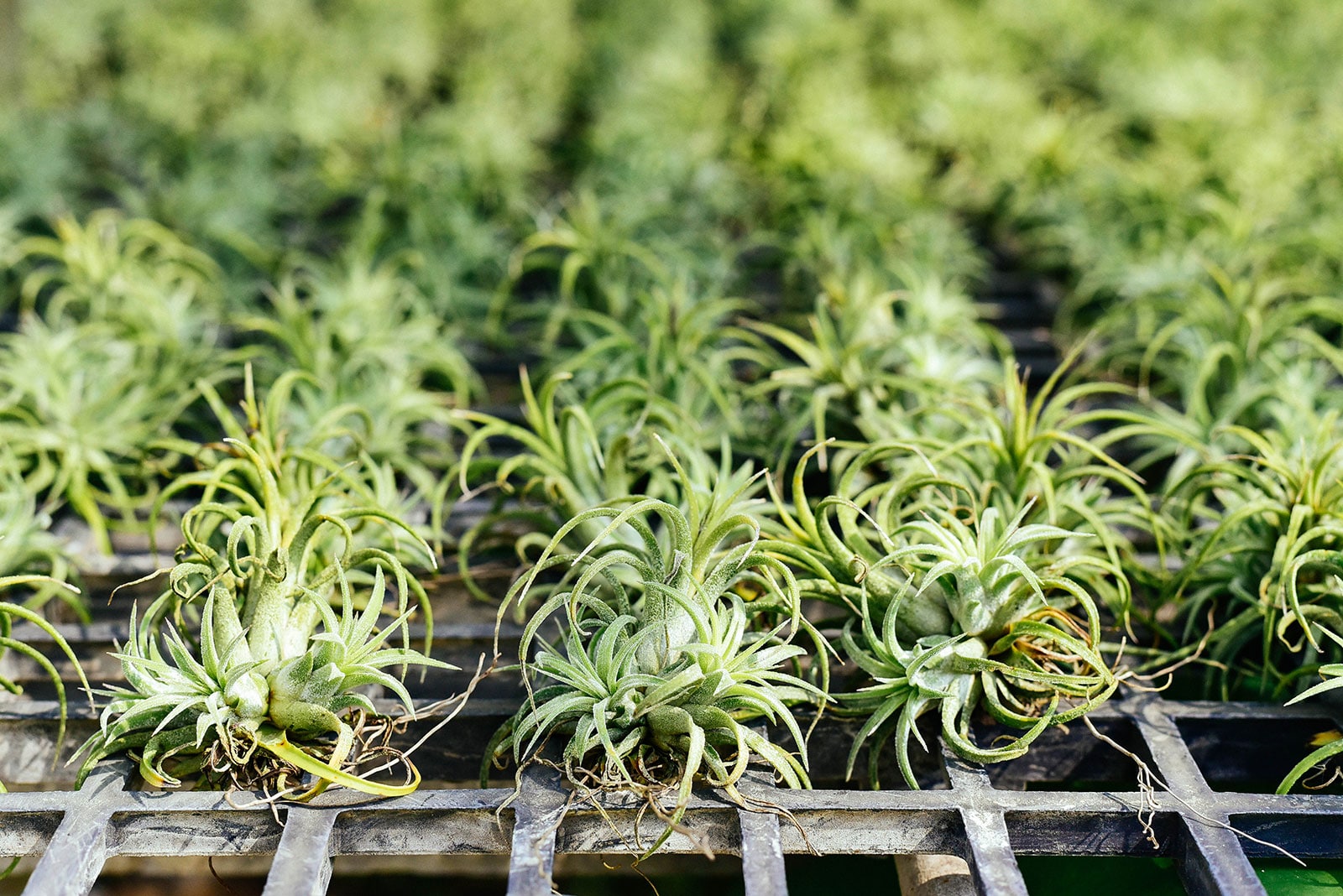
About air plants
Natural habitat
Air plants from the genus Tillandsia are naturally found in the Americas, all the way from the southeastern United States down to central Argentina (Granados Mendoza et al., 2017). Their natural habitats can vary from shaded rainforests to arid, exposed semi-deserts.
What all air plants do have in common is that they don’t grow in soil. Instead, they have evolved to grow in trees in a non-parasitical manner (making them epiphytes, similar to flamingo flowers, orchid cacti, and Christmas cacti in their native habitats) or on rocks (making them lithophytes like Anthurium clarinervium and Hoya carnosa).
This is something quite typical of the overarching family they belong to, the Bromeliads (Bromeliaceae).
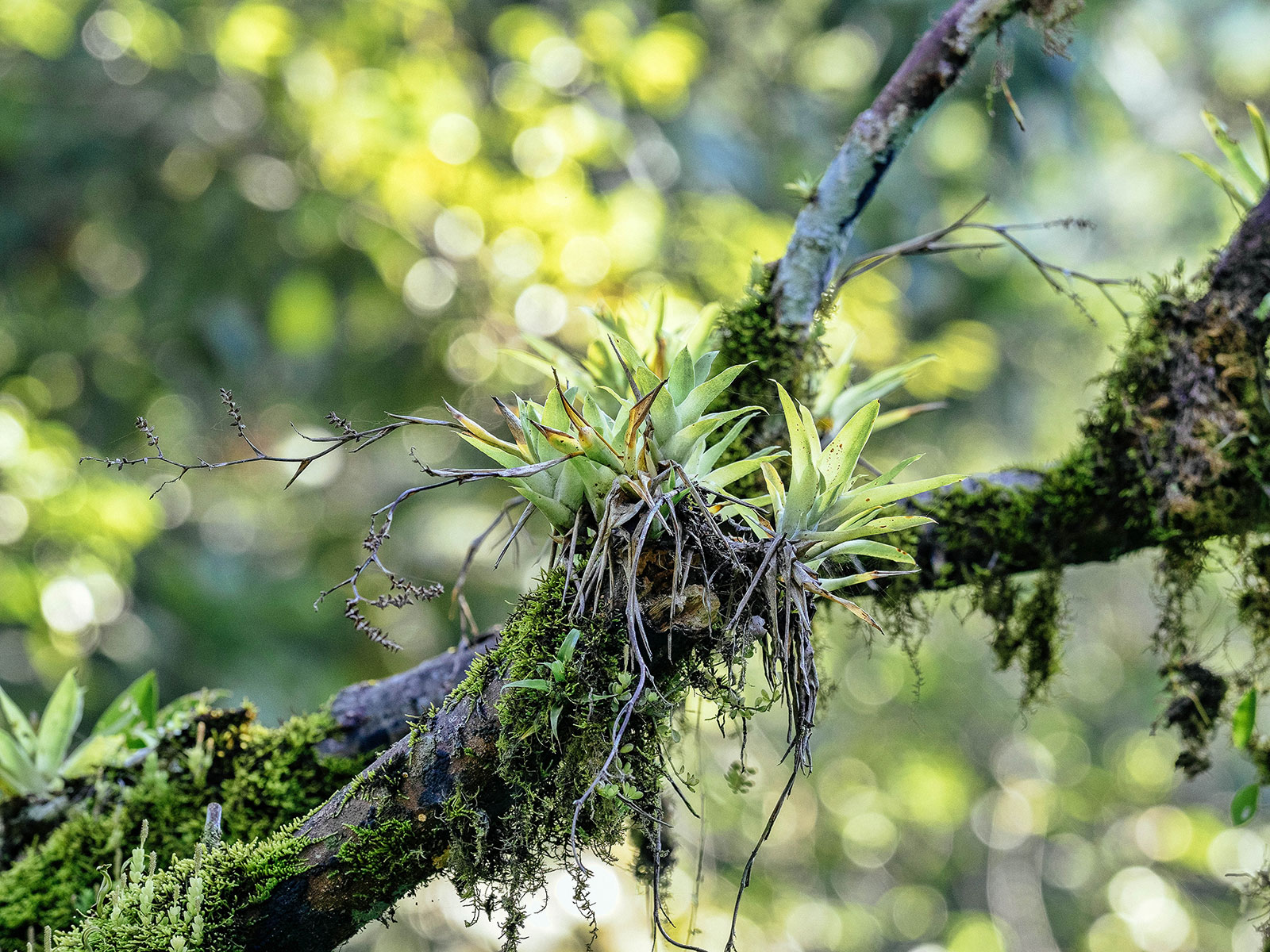
Most of the species have a complex relationship with their environment, benefiting in all sorts of ways from their host trees. For example, some air plants specifically grow on tree species like oaks, which leach high rates of minerals that the Tillandsia can use as nutrients.
On the other hand, the air plants’ often colorful flowers are important to hummingbirds and other pollinators (Aguilar-Rodríguez et al., 2014), and they also offer shelter to all sorts of small critters.
Related: Simply Perfect Hummingbird Food Recipe (and Why You Should Always Make Your Own)
Did you know?
As members of the Bromeliad family, air plants are actually closely related to pineapple plants.
Description
This is a funky houseplant if there ever was one! Some species look truly alien, and there are loads of variation within the genus Tillandsia—not too surprising given the fact that they occur in so many different habitats, but it makes it difficult to provide a general description.
Still, there are a few things most species have in common:
- Like many other members of the Bromeliad family, the majority of air plant species grows in a rosette fashion. They feature a sort of central “cup” that water collects in.
- Air plants don’t grow in soil, but they can have roots. These aren’t meant to absorb moisture or nutrients, but rather, to help the plant latch onto surfaces like tree branches or rocks. (Aerial roots are also found in creeping epiphytes like Syngonium podophyllum and Hoya kerrii.)
- Air plants flower (and yes, many do so inside the home as well!). Their blooms are usually very colorful, often pink, purple, and yellow, and they result in little seed parachutes that are naturally carried by the wind.
- Also typical of the family Bromeliaceae is the fact that many air plants grow in a clumping manner. A mother plant eventually dies off after flowering, but not before producing plenty of offsets. This can lead to impressive air plant balls!
Did you know?
If you’re from the southern United States, you might already be well acquainted with air plants, as the Spanish moss hanging from trees is one of the many species: Tillandsia usneoides. The same goes for ball moss, better known as Tillandsia recurvata.
Uses and cultural significance
As mentioned earlier, Tillandsias like Spanish moss are an integral part of that “Southern atmosphere” you get in states like Georgia and Texas.
Be careful though: Anyone in these regions will tell you to stay away from these plants, as they carry chiggers, which are annoying bitey bugs.

In Central and South America, locals have long used different Tillandsia species for all sorts of purposes. According to a 2019 paper by Estrella-Parra, Flores-Cruz, Blancas-Flores, Koch, & Alarcón-Aguilar, some of these uses include:
- Historically as fibers in pottery
- As cattle feed (Tillandsia usneoides or Spanish moss)
- As decorations in Aztec temples
- For wrapping fruit and fragile wares as well as stuffing pillows and blankets (Tillandsia usneoides)
- As part of culturally significant magical rituals
- As a natural medicine for ailments like hemorrhoids, ulcers, inflammation and loads more
It has even been suggested that some Tillandsia extracts have uses in anti-aging and other cosmetics.
The massive-scale cultivation of air plants as houseplants is relatively new. Some growers saw them as a good alternative to other Bromeliad species, as they don’t tend to collect standing water, which can be a mosquito risk (Dematte, 2005).
Clearly, they caught on! You can now find air plants in every plant store and there are even plenty of (online) shops, as well as websites, dedicated solely to Tillandsia.
Where to buy
Air plants (Tillandsia)
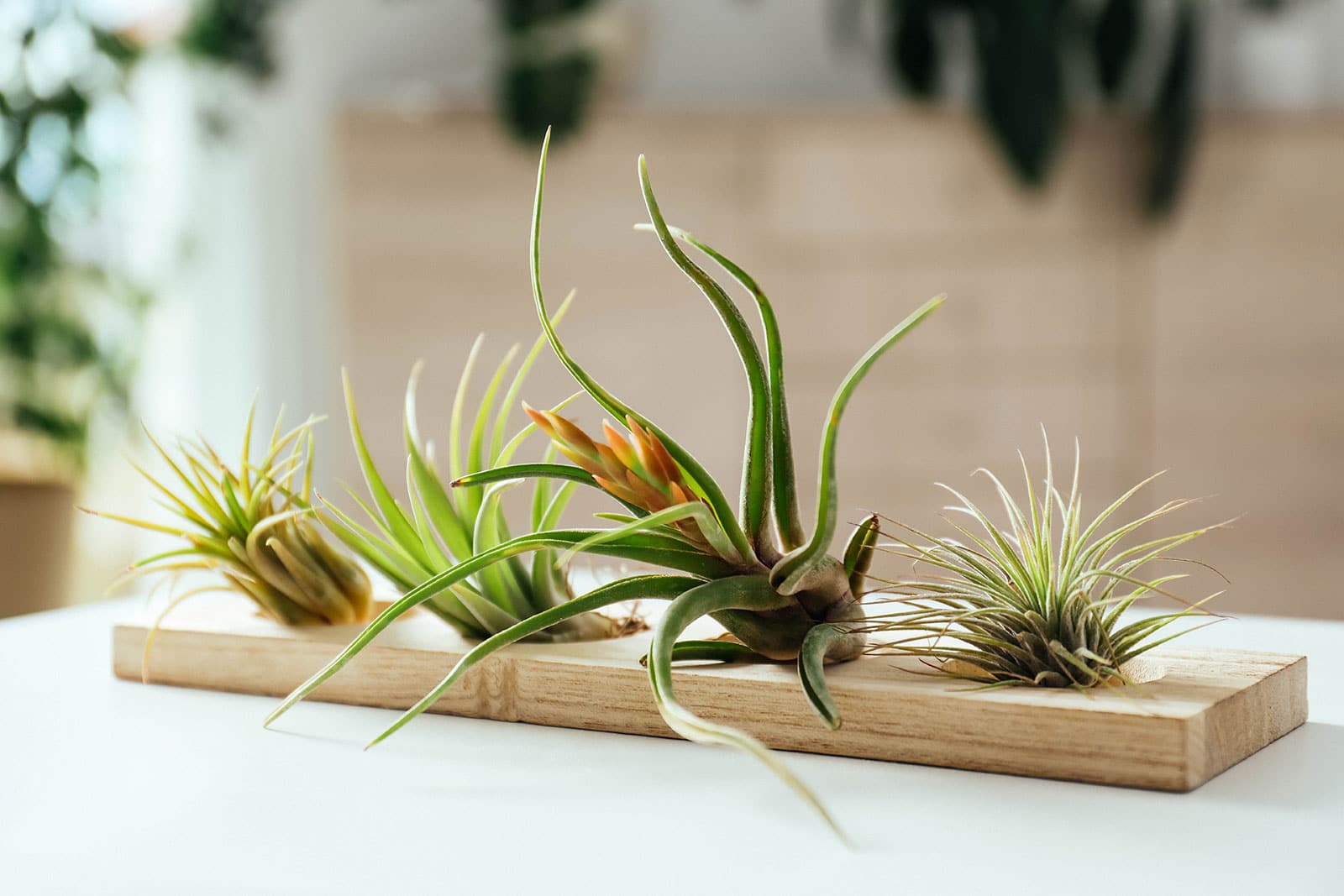
Air plant varieties
Tillandsia is not a small genus: There are around 650 species out there (Granados Mendoza et al., 2017).
Even in your local plant store, you’ll sometimes be able to find quite a few different air plants. All are specifically adapted to their natural habitat, which is why the different species can look quite different from one another.
Roughly speaking, you can divide Tillandsias into two groups: xeric and mesic.
Xeric Tillandsias are found in sunnier habitats that are prone to drought and fluctuating temperatures (think deserts and mountain areas where humidity is low and tree cover is sparse). They’re often growing on rocks at higher altitudes and are adapted to brighter, drier conditions.
Xeric air plants can be recognized from their fuzzier appearance. This fuzz actually consists of trichomes, the small silvery “hairs” an air plant uses to absorb water. Trichomes regulate the amount and timing of water allowed into the leaf and can protect the plant from sunburn.
Not only are xeric Tillandsias fuzzier than their mesic cousins, but they tend to be grayer in appearance as well.
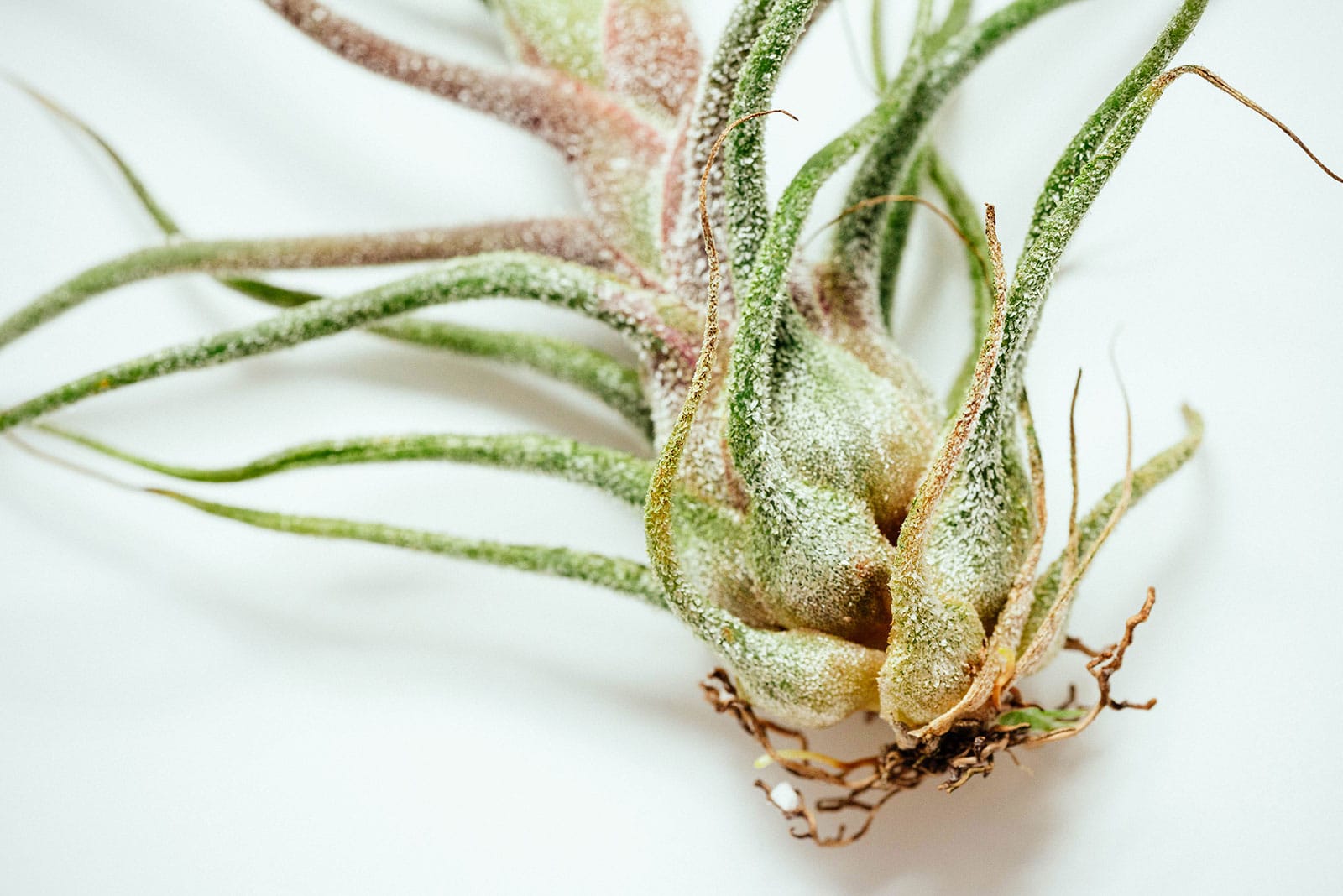
Mesic Tillandsias are mostly smooth in appearance (or at least have fewer trichomes), as the species naturally get plenty of air moisture from their moderately wet rainforest environments.
They can usually be found in cooler, moist habitats with more humidity and less direct light. (I’ll get back to this in the sections on light and watering, as it does influence the amount of light and moisture an air plant needs in the home.)
Mesic air plants tend to be on the greener side compared to xeric species, but just because they’re a “wet” plant doesn’t mean they actually like to stay wet all the time. It simply means they can tolerate more frequent watering.
Now that you know the differences between xeric and mesic Tillandsias, let’s discuss a few of the most popular air plant species—the ones you’ll likely find in your favorite plant store.
- Tillandsia xerographica: Sometimes referred to as the queen of Tillandsias, this rosette-shaped species can grow very large (and quite expensive!). It naturally occurs in dry forests in Central America, where it receives plenty of light. This makes it a xeric species. It’s one of my absolute favorite varieties of Tillandsia—in fact, I carried a single stunning xerographica as my wedding bouquet!
- Tillandsia ionantha: This is definitely the one I see most often in plant stores, and you might know it as a sky plant. The small Tillandsia ionantha is naturally green, but selective cultivation has led to red-tipped varieties as well. This, combined with its frequent purple flowers, makes it a real show-stopper! It’s a xeric species naturally found in Central America.
- Tillandsia stricta: Another popular species that has resulted in a variety of different cultivars. It’s found in much of South America and its habitat varies, which is why there are a few subspecies with different appearances.
- Tillandsia bulbosa: A decidedly mesic species, this one is naturally found in much of Central America as well as parts of South America. It’s a fun option for beginners and there are a few different cultivars!
- Tillandsia cyanea: Okay, this isn’t technically a Tillandsia—or not anymore in any case. It was recently recategorized into the genus Wallisia, but given its beautiful flowers, it’s definitely still worth a buy if you like Bromeliads. Unlike the other air plants on this list, it’s grown in soil.
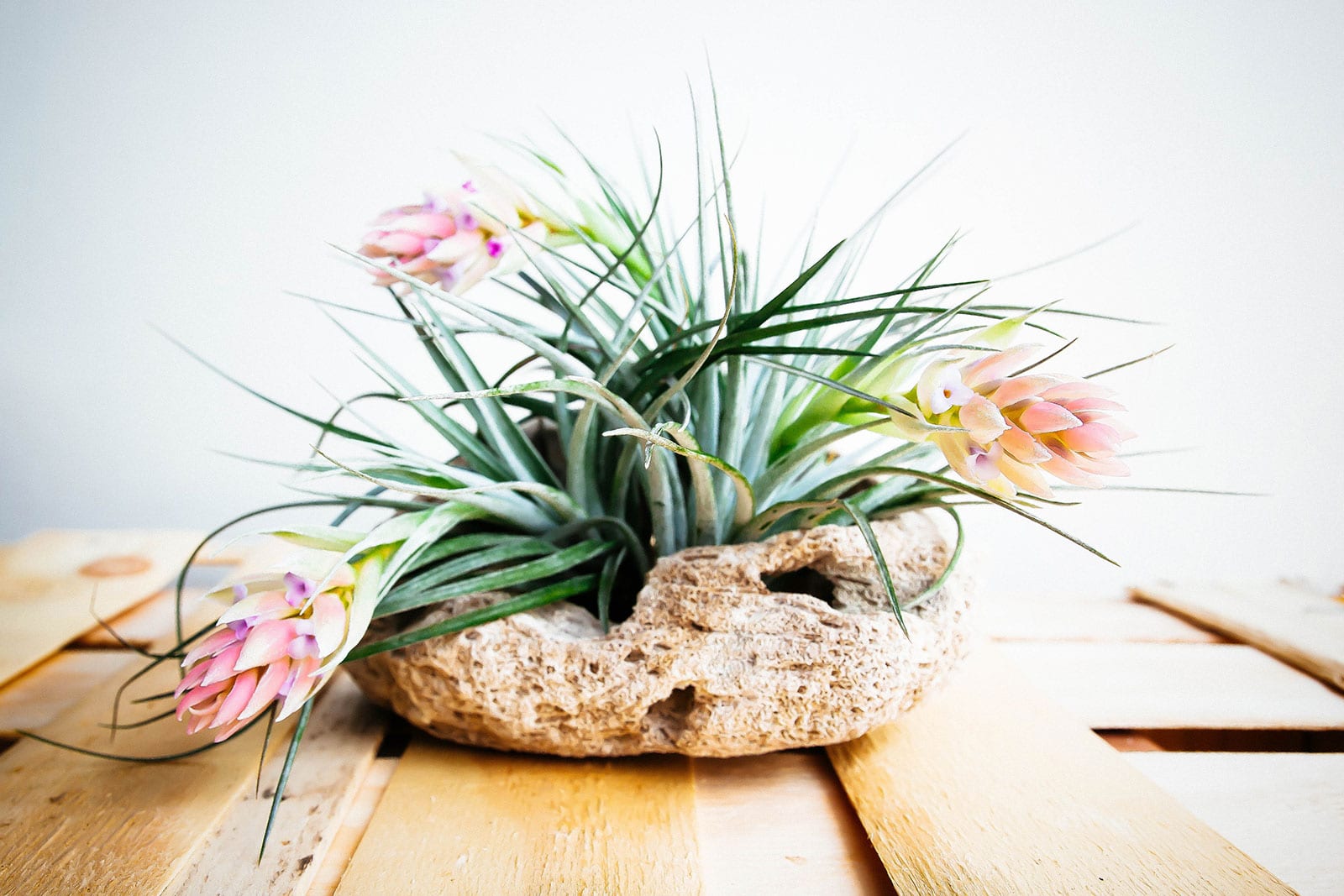
Caring for an air plant
Light and temperature
In the home, most air plants will generally do fine in bright indirect light. This being said, depending on the species, you can opt to give them a little more or less.
Xeric air plants hail from areas that tend to be more exposed, which means they’re adapted to receiving more direct sun than their mesic cousins.
Basically, the fuzzier your air plant, the more xeric it is, and the more direct sun it will prefer.
In terms of temperature, the ideal range will also depend on the species of air plant you’ve got on your hands. Room temperature should be fine, though 50°F is the lowest most will be able to take: any colder and they can start suffering, or at least stop growing.
When it comes to warmth, they can handle pretty much anything you can throw at them, as long as they’re not being literally burned by the sun.
Water and humidity
If you’re not familiar with growing air plants, this is probably the bit you’re most confused about. But no worries, it’s not that complicated!
Instead of keeping your plant hydrated by pouring water into the soil, you can do so by spraying, dunking, or soaking them.
The preferred method and frequency depend on factors like the type of air plant, airflow levels, amount of light, and air moisture. You’ll have to experiment a bit to figure out what works for your plants!
My own preferred method is to soak most (but not all) of my mesic air plants in a bowl of water for half an hour every 10 to 14 days (depending on the season). Between soaks, I lightly spray them with water whenever I remember to, as they tend to be thirstier.
For my xeric plants, I dunk or spray them (never soak) every 10 to 14 days and keep an eye on them in between waterings.
Sometimes they’ll need more frequent mists of water (especially in a warm, sunny home in summer) and sometimes they’ll be quite happy going two weeks without any hydration (especially if they’re placed in an area that gets less light and stays on the cooler side).
Even more important than the watering frequency, however, is proper drying. Air plants will tell you themselves if you’ve waited too long to water by curling and tightening their leaves, so it’s difficult to let them get too thirsty.
The true danger is in the possibility of rot: due to their rosette-like growth pattern, air plants can trap moisture between their leaves or even their bulbous base.
You really need to dry your Tillandsias upside-down to drain excess moisture (I do this in a dish drying rack or on a kitchen towel), and possibly even consider a gentle fan to ensure they dry well after a good soak.
As for air humidity, an overly dry environment isn’t ideal, although xeric air plants won’t suffer as much as their moisture-loving mesic cousins.
This means that if your home tends to be on the dry side, it can be a good idea to opt for the fuzzier species, which have more trichomes for extra efficient water uptake.
Soil and planting
One of the reasons so many houseplant enthusiasts adore air plants is because they have plenty of freedom to be creative. No pot is needed, so it’s up to you to come up with a fun air plant holder!
Or don’t—you can just set your Tillandsias down on any surface and leave it at that.
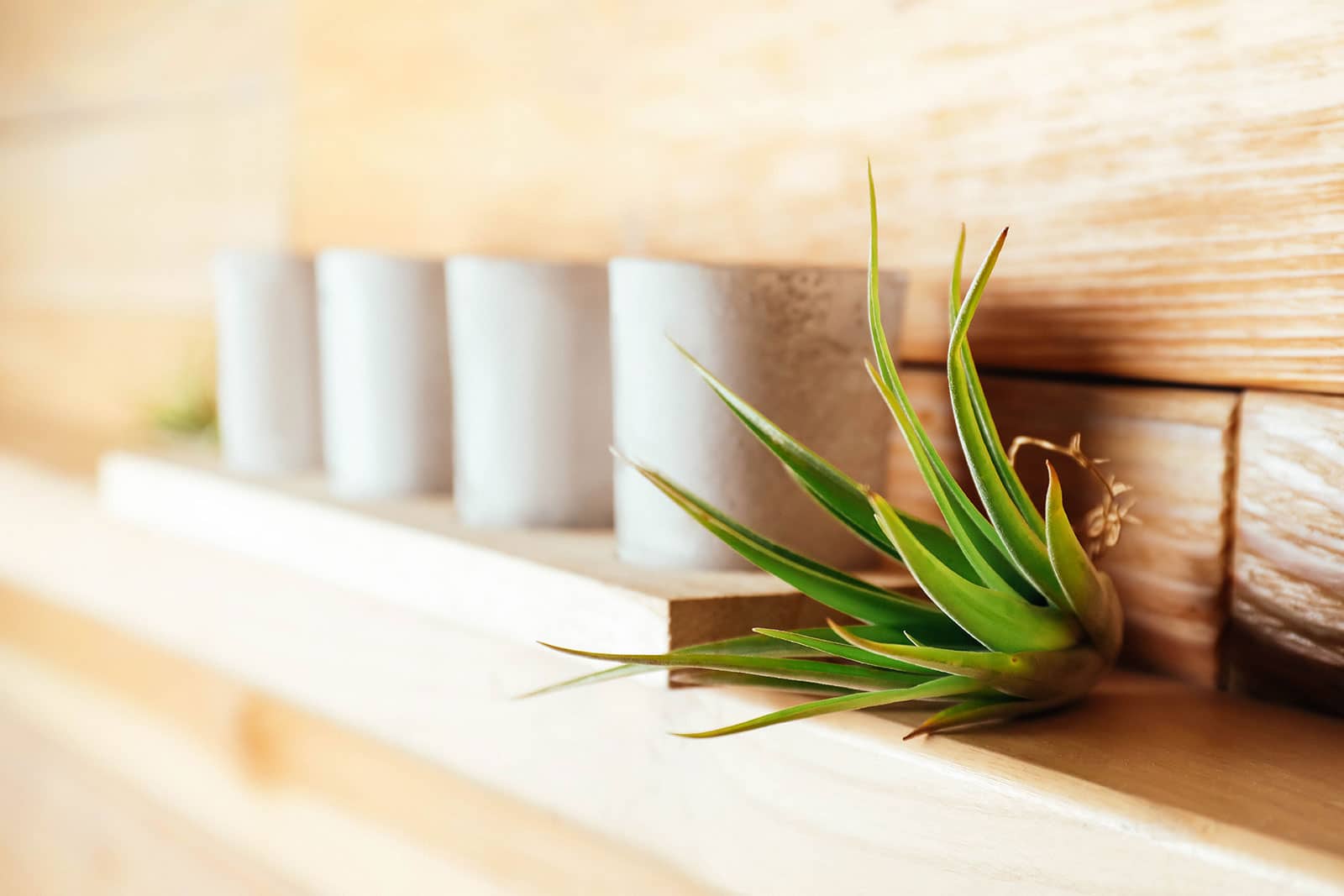
I like to display my tiny Tillandsia plants inside natural vessels like barnacle shells, sea urchin shells, and coastal rocks filled with holes.
Larger Tillandsias can be mounted on wooden boards (I especially love boards with a live edge), driftwood logs, or wreath forms; set in macrame or ceramic plant holders; or hung in kokedama-style arrangements.
Did you know?
A terrarium is a popular option for air plants, but it’s not ideal. These guys need good airflow to prevent rot, which a terrarium unfortunately tends to lack. Copper wire holders are also not ideal, as this particular metal can become toxic to your plant when it oxidizes.
There are a few different ways you can mount your Tillandsia without harming the plant—I’ll get to that in the next section below.
My favorite places to buy stylish air plant holders:
If you’d like to do something fun with your air plant, here are a few options I’m a fan of:
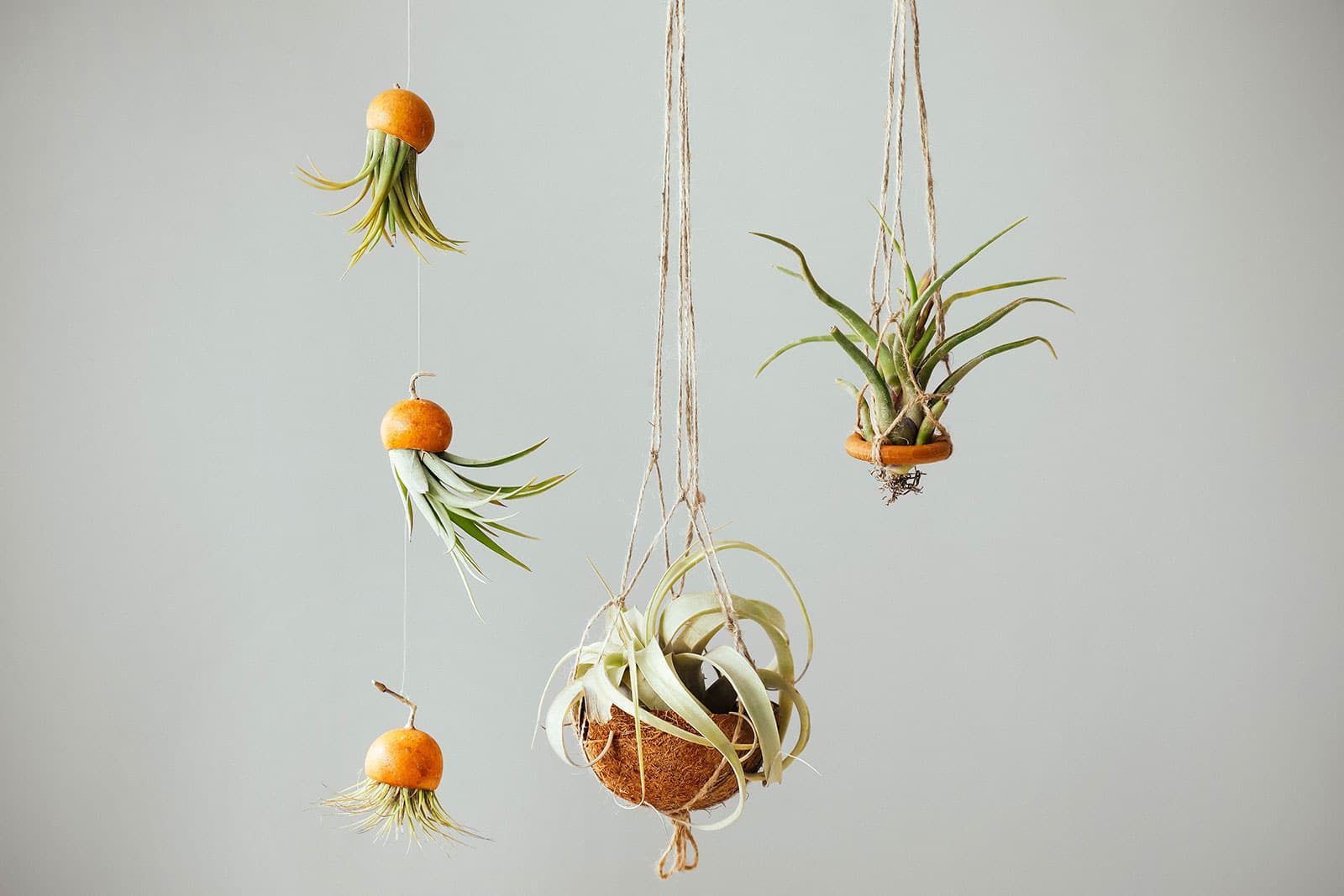
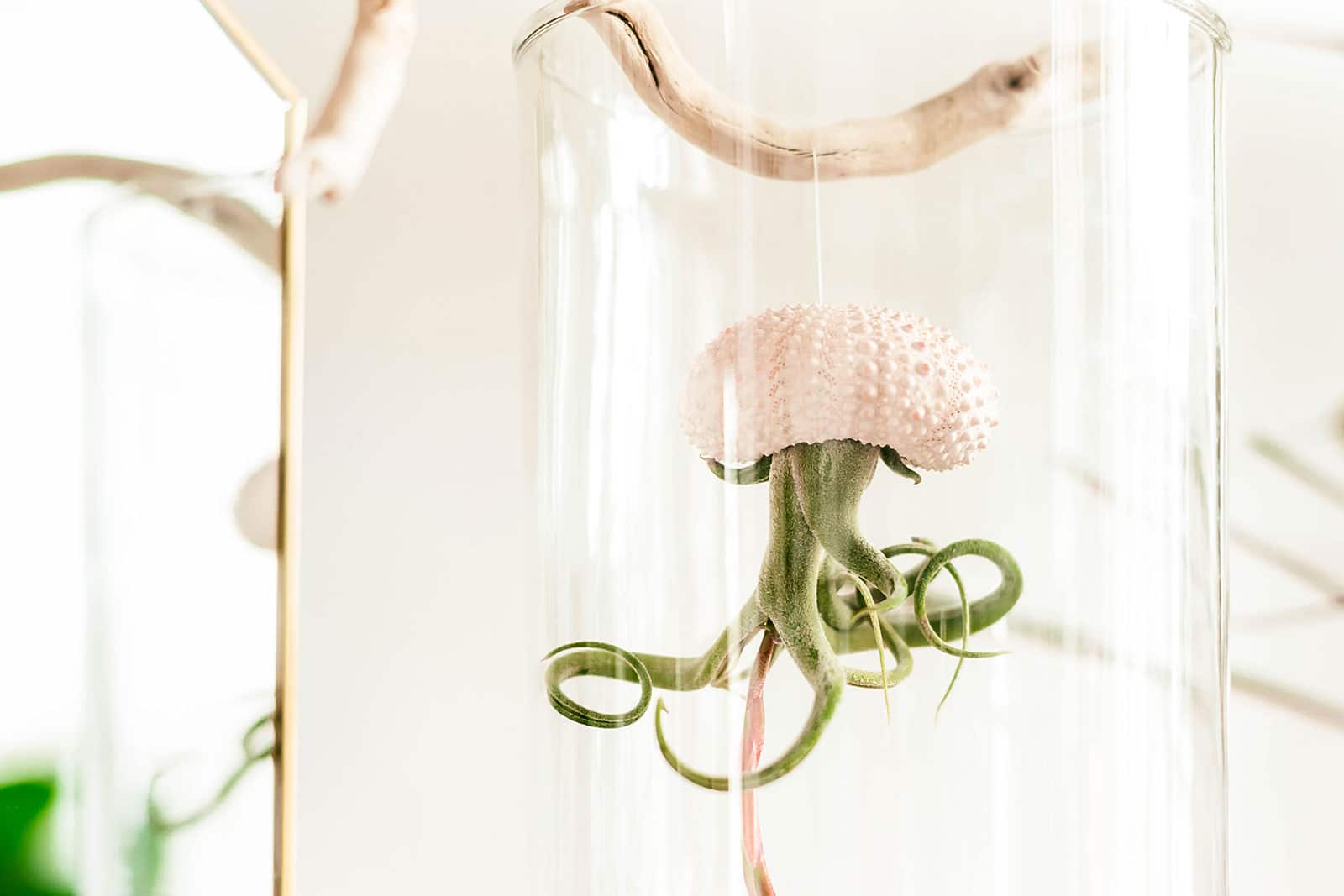
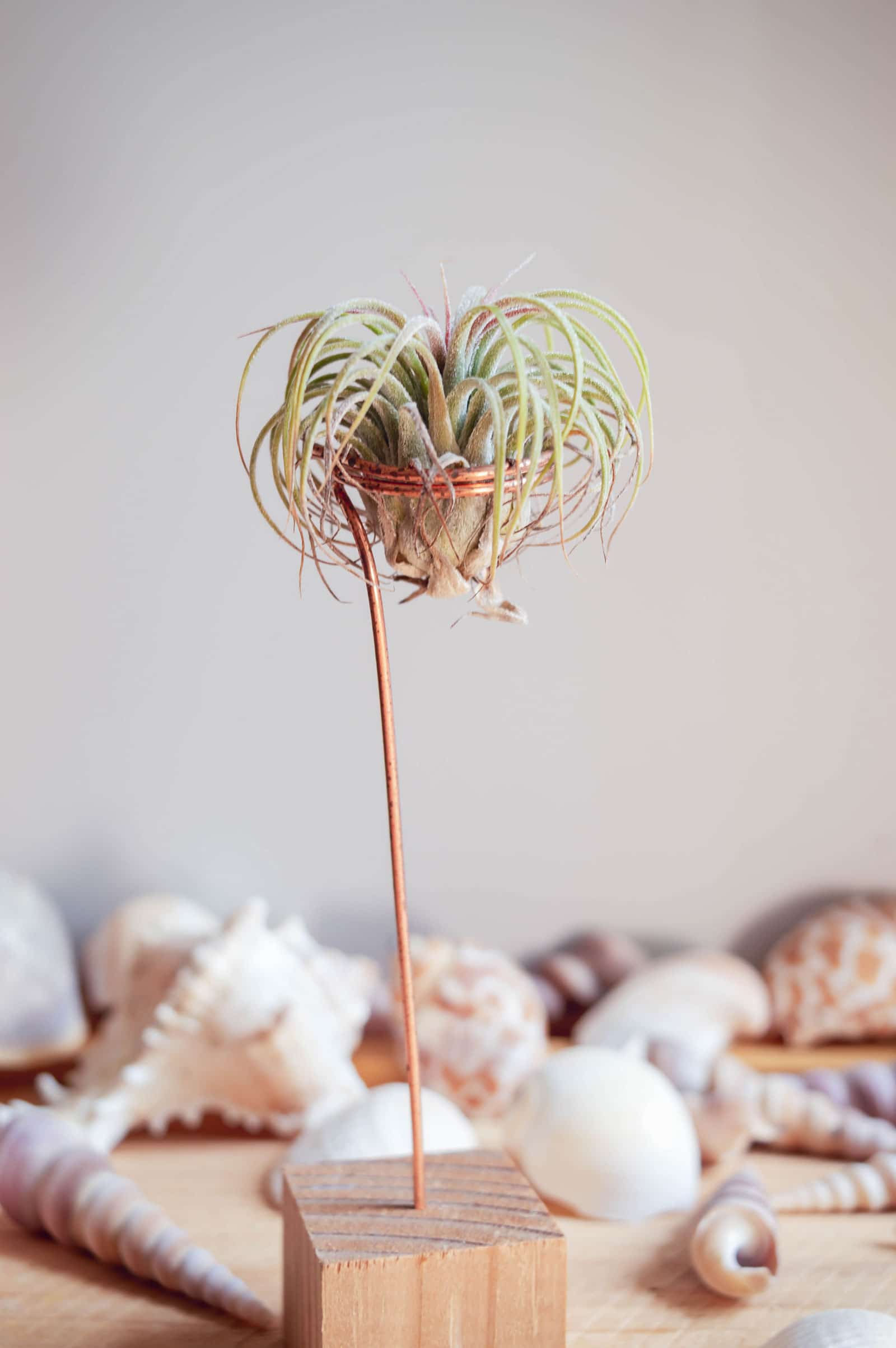
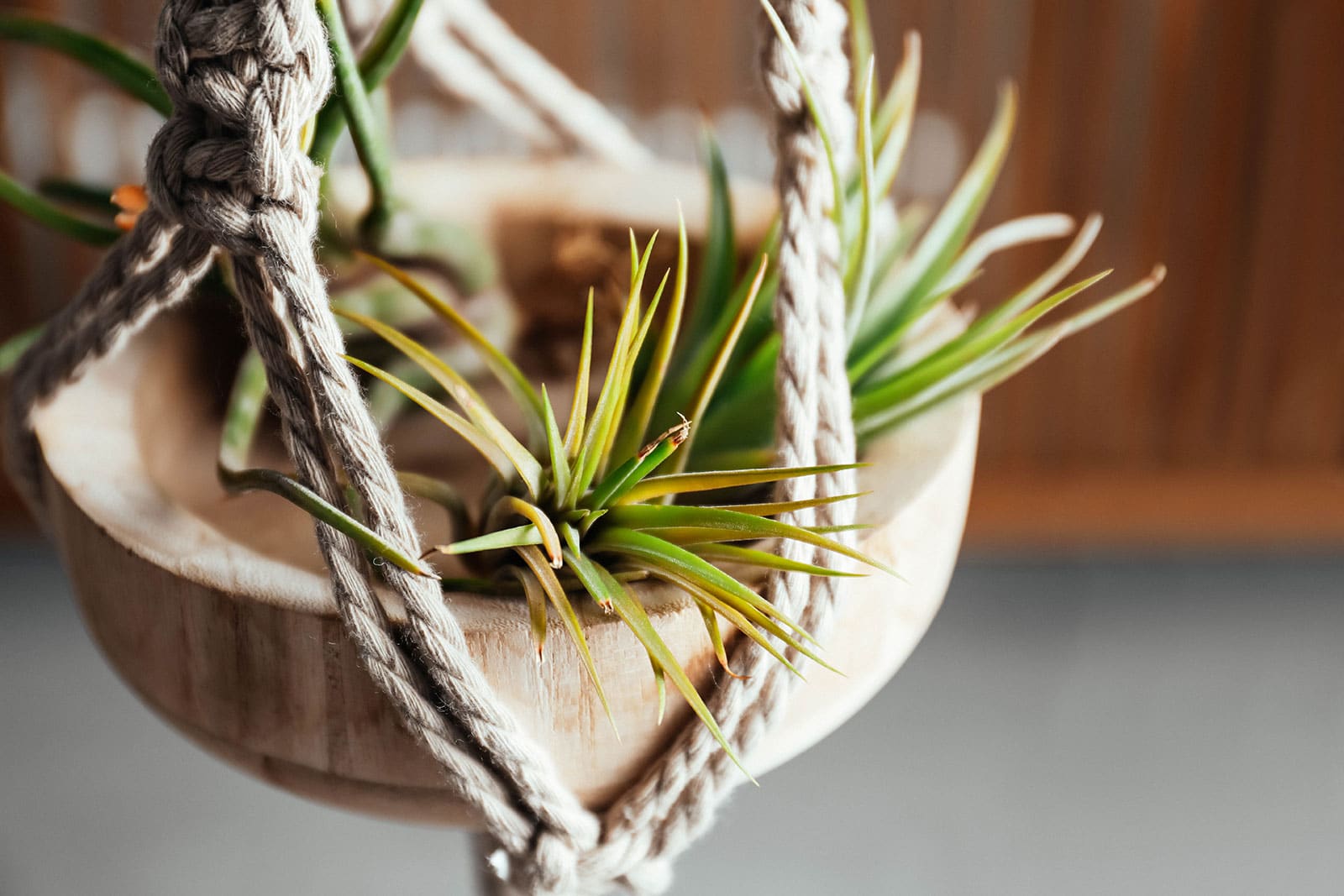
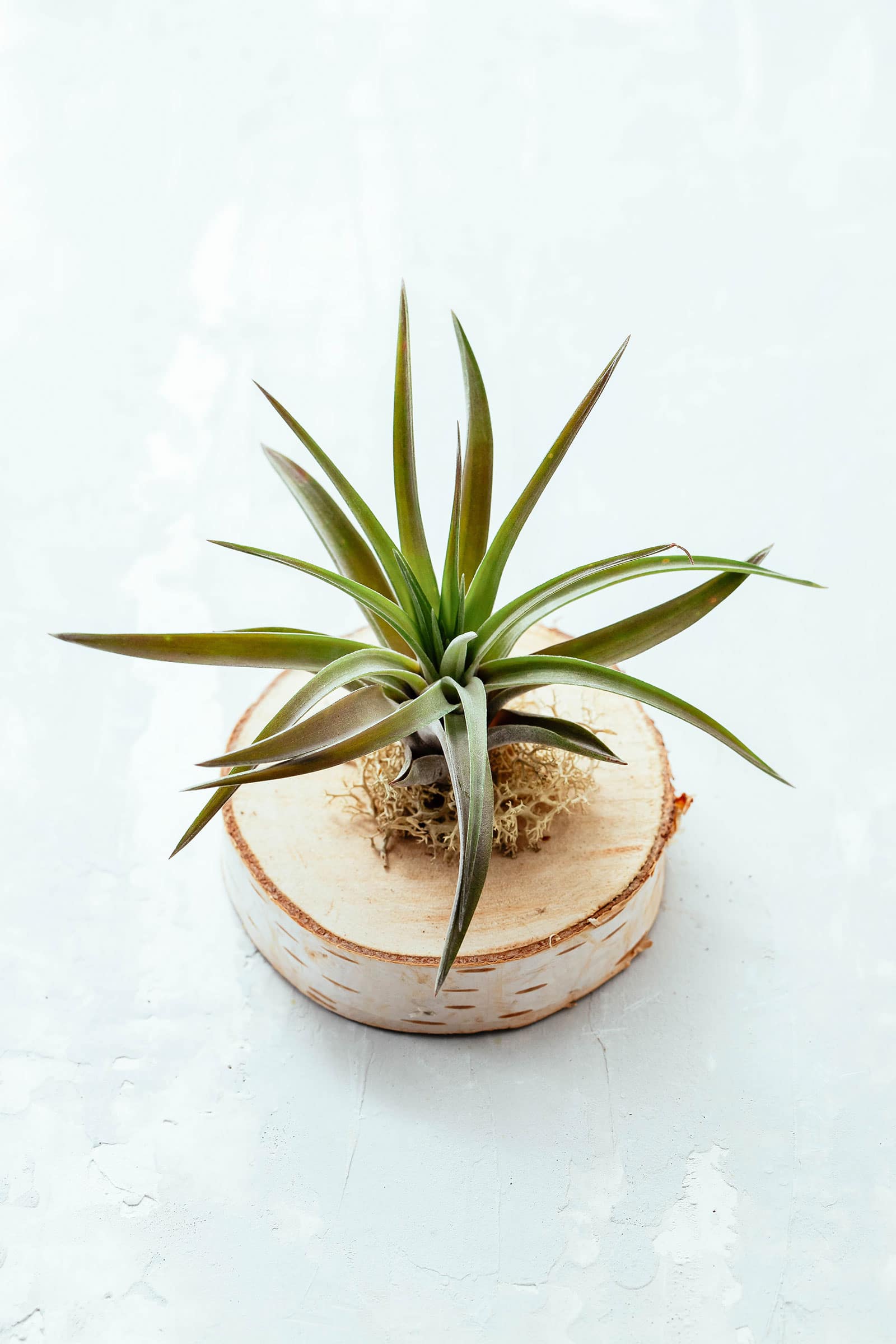
Fertilizing
Just like any other houseplant, your air plant will appreciate a little bit of fertilizer from time to time if it’s growing well.
During the spring and summer growing months, you can use a special Bromeliad or Tillandsia fertilizer. These usually come in spray bottles, although some require you to mix the fertilizer yourself.
If you’ve got access to a pond or aquarium, you’re in luck. Your air plants will love a soak in some nutrient-rich fish water and it’s a great free alternative to normal fertilizer.
Recommend fertilizers for Tillandsia plants:
- The Grow Co. Organic Air Plant Food
- Cute Farms Tillandsia Air Plant Fertilizer
- Aquatic Arts Air Plant Fertilizer
- Grow More Ready-to-Mix Bromeliad Tillandsia Food
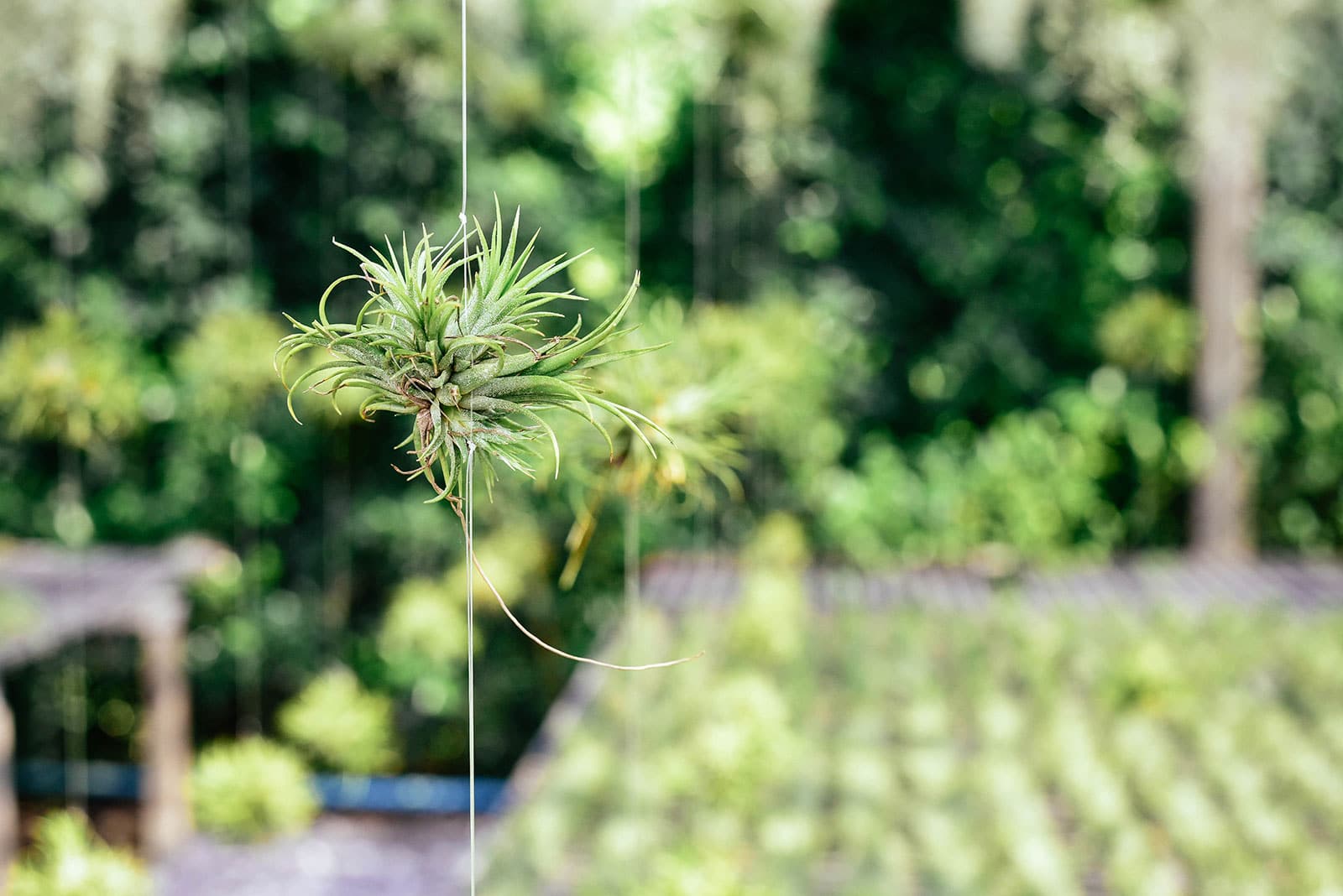
How to mount an air plant
If you’re wondering what’s the best way to mount a Tillandsia, here are some of my favorite methods for attaching an air plant to nearly any surface.
Wire
I usually recommend using wire whenever possible (except copper wire, which can be toxic to air plants). When using wire, carefully loop the wire through the bottom leaves, wrap it around the base a few times, then attach to a frame or other object.
Fishing line
This is similar to wire, except the clear line makes the mounting nearly invisible, which is a plus! Just like you do with wire, weave the line around the air plant a few times, tie it to the mounting surface, and secure the end with a knot.
With some ingenuity, you can create some stunning floating displays if you attach your air plants to a long line and hang it from the ceiling.
Glue
Not just any glue, but a waterproof adhesive that’s safe for air plants. Glue is a good choice for mounting air plants to driftwood pieces, rocks, and other surfaces where you want the anchor point to be completely invisible.
I recommend E6000 or Tilly Tacker; be careful not to get any glue on the leaves, just dab it on the base and let it dry.
Keep in mind that if you glue your air plants, you won’t be able to soak them. So this method is best for air plants that prefer to be sprayed rather than soaked: Tillandsia xerographica, Tillandsia tectorum, Tillandsia magnusiana, species with wispy leaves like T. fuchsii v gracilis and T. andreana, and bulbous species like T. bulbosa, T. caput medusae, T. pruinosa, T. pseudobaileyi, T. butzii, and T. seleriana.
Here’s a video from my favorite air plant nursery demonstrating how to use Tilly Tacker to attach air plants to a piece of wood.
Propagating an air plant
Remember when I said that air plants tend to grow in a clumping fashion? They tend to die off after flowering, but not before producing offsets. These can be found at the mother plant’s base and offer a fantastic easy method for air plant propagation.
If you’d like to multiply your air plant, all you need to do is to keep caring for an offset-producing mother plant until the pups reach at least one-third of her size. Once they’re ready to continue life solo, you can carefully break them off and continue caring for them as you would for any other air plant. Yep, it’s really that simple!
Did you know?
You can grow air plants from seed if you manage to pollinate a flower. It’s a bit of a hassle though, mostly due to the teeny tiny size and slow growth of the resulting baby plants. Germinating air plant seeds is a project best suited to the true Tillandsia enthusiast!
Common questions about air plant care
Are air plants toxic to cats and dogs?
Nope! Air plants make a great, safe option if you share your home with kids or a furry or feathered friend. They’re easy to keep out of reach of curious small hands or paws because they don’t need to be planted, and if anyone does manage to take a bite out of an unfortunate Tillandsia, the plant will be the only victim.
How long should you soak air plants?
Soak your air plants (mesic species only) in a sink, bowl, or bucket filled with water for at least 20 minutes and up to 1 hour. Submerge the entire plant, though if it’s starting to bud, it’s best to keep the bud above water so as not to disturb it.
Once your plant is thoroughly soaked, give it a good shake and let it dry upside-down to keep excess moisture from pooling in the center, which promotes rot.
Which air plants should not be soaked?
Watering is often the trickiest part of caring for air plants, as some species like to be soaked (mesic Tillandsias) while others prefer to be dunked or even just lightly misted (xeric Tillandsias).
In general, the fuzzier the air plant, the less it likes being soaked, as the trichomes (small silvery hairs) make the plant more susceptible to rot.
Air plants that should never be soaked include Tillandsia tectorum; Tillandsia magnusiana; Tillandsia xerographica; species with wispy leaves like T. fuchsii v gracilis and T. andreana; and bulbous species like T. bulbosa, T. caput medusae, T. pruinosa, T. pseudobaileyi, T. butzii, and T. seleriana. To water these plants, simply give them a quick dunk in water or spray them more frequently to keep them hydrated.
Why do my air plants always die?
Proper watering habits and airflow make all the difference! It’s better to underwater your air plant than to overdo it. Dry your Tillandsias well after watering (ideally upside-down to drain all excess moisture) and keep them in a spot that gets lots of fresh air.
Sources:
- Aguilar-Rodríguez, P. A., MacSwiney G, M. C., Krömer, T., García-Franco, J. G., Knauer, A., & Kessler, M. (2014). First record of bat-pollination in the species-rich genus Tillandsia (Bromeliaceae). Annals of botany, 113(6), 1047-1055.
- Dematte, M. E. S. P. (2005). Information on Brazilian ornamental species of the genus Tillandsia L.(Bromeliaceae). Acta horticulturae, 683, 293.
- Estrella-Parra, E., Flores-Cruz, M., Blancas-Flores, G., Koch, S. D., & Alarcón-Aguilar, F. J. (2019). The Tillandsia genus: history, uses, chemistry, and biological activity. Boletín Latinoamericano y del Caribe de Plantas Medicinales y Aromáticas, 18(3).
- Granados Mendoza, C., Granados-Aguilar, X., Donadío, S., Salazar, G. A., Flores-Cruz, M., Hágsater, E., … & Magallón, S. (2017). Geographic structure in two highly diverse lineages of Tillandsia (Bromeliaceae). Botany, 95(7), 641-651.


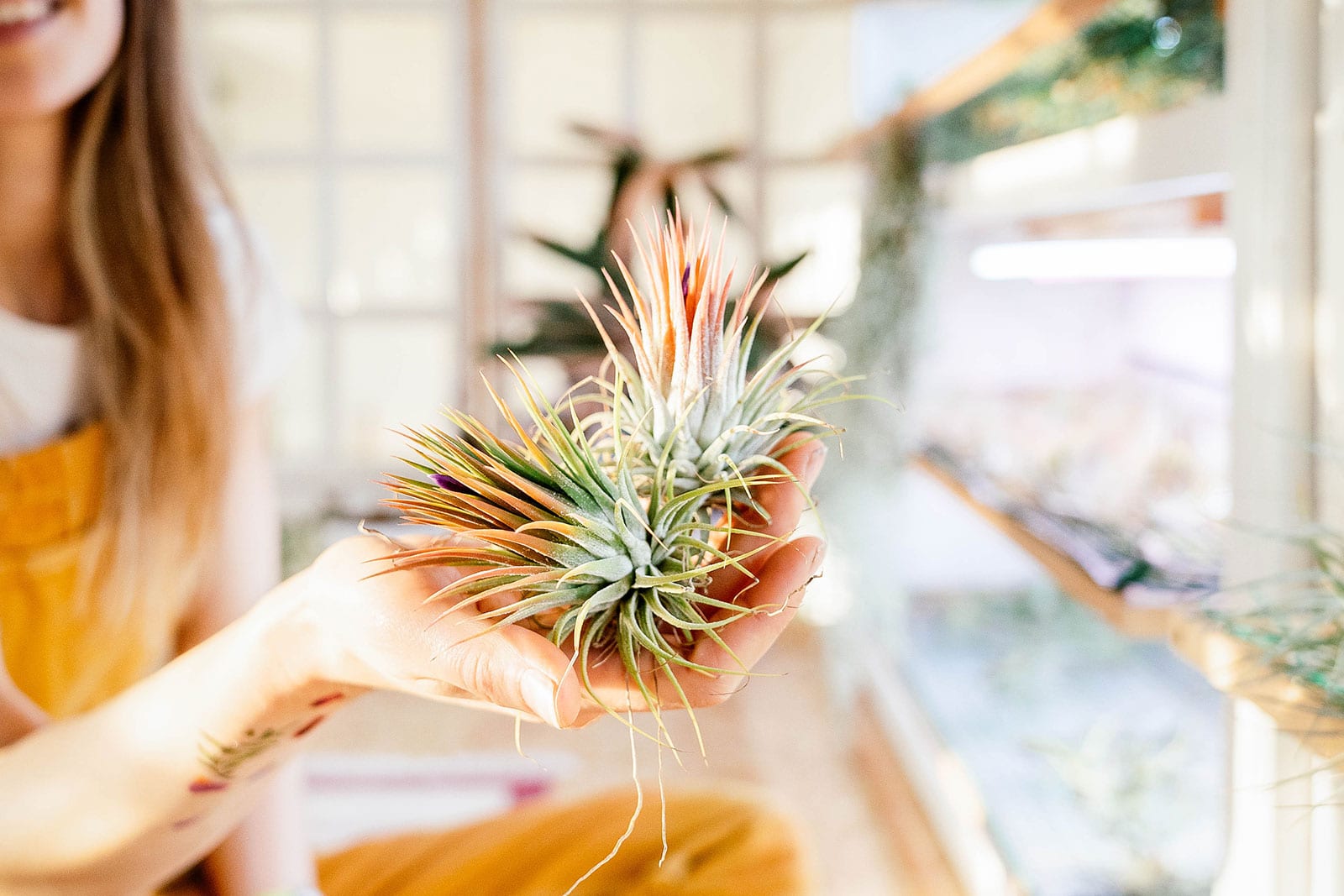













I have my air plant on the north-facing windowsill in my bathroom – I’ve had it for about 6-8 weeks now. I’ve never sprayed it but have a shower every day (my husband showers every second day in the same bathroom) in the morning. When we went on a week’s vacation, I put a jar of water beside it. Does it still need to be sprayed?
It looks like it has a bit of dry mold on it when I looked at it today; can I send you a picture of it? Can you email me your email?
What’s your fertilizing regime?
I covered fertilizing in this post with recommendations for different fertilizers you can use. The timing will depend on the fertilizer; just follow the instructions on the package.
With so many varieties and each having very specific (and different) care needs, photos of each variety would have been really helpful!